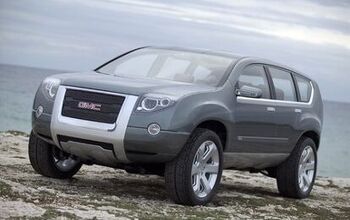General Motors Death Watch 77: Bull
Why is GM's stock rallying to a six-month high? Delphi's Sword of Damocles still sways above The General's head. Their market share and sales continue sliding towards Hades, with Cerberus waiting to lock the gate behind them. Oh right, I remember. On Wednesday, Merrill Lynch analyst John Murphy upgraded GM's stock to "buy." He made the move in light of the fact that 20k GM employees have decided to take advantage of GM's worker buyout program. So a bunch of rats leave a sinking ship, someone says well done and the crew breaks out the champagne. This thing stinks.
Lest we forget, until February 7th, the Chairman and CEO of Merrill Lynch & Co., Inc. served on General Motors' Board of Bystanders. When Stan O'Neal resigned from GM, the exec cited time constraints and "limits on my ability to act as a GM director because of potential conflicts with matters in which Merrill Lynch is involved." This limitation didn't stop O'Neal's firm from buying 32m shares of FIAT stock for $1b while O'Neal was on GM's Board– immediately after GM wrote off the value of its FIAT stock for $2.1b. Be that as it is, there's clear evidence that Merrill and GM are deep into each other's pockets.
On June 1st, 2004, Merrill elected John Finnegan to their Board of Directors. Finnegan is the former Executive Vice President of General Motors Corporation and former Chairman and President of General Motors Acceptance Corporation (GMAC). On June 23rd, 2005, Merrill elected Armando Codina to their Board of Directors. Codina is a Florida real estate maven who's been on GM's Board of Directors since 2002. So, despite O'Neal's concern over conflicts of interest, Merrill's board is rife with ex and current GM'ers, and The General and Merrill still have interlocking directorships. Now, let's get to the nub of the matter….
Again, GM's stock price surge was triggered by John Murphy. In his report "Buy on buyouts and other options" the Merrill Lynch analyst flagged three keys to GM's turnaround– downsizing production, securing a new labor deal and reinvesting in product. 'There appear to be early signs of these steps being taken,' Murphy claimed. His primary justification and main piece of supporting evidence: the 20k take-up on GM's worker buyout plan. Murphy predicated the program would save The General about $2.3b in pretax cost and $1.8b in cash per year and… that's it. Buy!
OK, sure, Murphy's report cautions three times that "Risks include a low buyout rate [in case the workers suddenly change their mind], a Delphi strike, market share losses, rising gas prices, pricing, cyclical downturn, residual erosion, and dealer body risk." And Merrill's man pegs GM's "defensible market share" at a dealer-indefensible 19%. But hey, what's all that compared with the buyout plan's theoretical addition of $2.48 per share! In fact, once GM gets some relief from "negative sentiment" (are you talking to me?), their share price should rise to $37. Hang on; has TTAC's Death Watch being blowing smoke all this time?
Nope. While Murphy's analysis acknowledges the obvious hurdles, his conclusions ignore their implications. GM is not an earnings story but a cash flow story. GM's cash flow is negative and will remain so as they unwind plants, pay for worker buyouts and write-off all the other items on the debit side of the corporate ledger. Thus, earnings may appear positive, but there are underlying cash calls– both actual and potential– which require extreme funding. For example, any non-strike resolution of the Delphi debacle will require GM cash, and lots of it. And while we're at it, Murphy's calculations must assume that GM can cut costs to keep margins in line or better in light of declining sales.
Yes, there is that. The launch of GM's "gas price protection" promise in California indicates that income is slowing. Refreshed SUV's or no, GM has too much inventory on dealer lots going into the season of high gas prices. While it might be 100k units less than last year, GM's sales have also fallen. It's only a matter of time before The General is forced to do something, anything to move the metal. Whatever it is, it'll come straight off the bottom line.
OK; Merrill's man has both the means and the opportunity to inflate GM's stock price (ipso facto). What's the motivation? Pump and dump. The report could be a favor to The General and its management, designed to drum-up banking business and let share-owning employees come up for air. Or it could be a favor to Kirk Kerkorian, to drum-up banking business. Or it could be a way to generate business for the Merrill retail network. (GM's erstwhile recovery is an easy story to tell to naïve retail customers.) Or it could be all three. Remember: this is the same firm that paid an $80m fine for fraud relating to Enron's collapse, and more than $200m in penalties for systematically hyping stocks on behalf of their investment banking clients. No wonder S&P and BoA Securities still say sell. They tell the truth.
More by Robert Farago
Latest Car Reviews
Read moreLatest Product Reviews
Read moreRecent Comments
- Dartman https://apnews.com/article/artificial-intelligence-fighter-jets-air-force-6a1100c96a73ca9b7f41cbd6a2753fdaAutonymous/Ai is here now. The question is implementation and acceptance.
- FreedMike If Dodge were smart - and I don't think they are - they'd spend their money refreshing and reworking the Durango (which I think is entering model year 3,221), versus going down the same "stuff 'em full of motor and give 'em cool new paint options" path. That's the approach they used with the Charger and Challenger, and both those models are dead. The Durango is still a strong product in a strong market; why not keep it fresher?
- Bill Wade I was driving a new Subaru a few weeks ago on I-10 near Tucson and it suddenly decided to slam on the brakes from a tumbleweed blowing across the highway. I just about had a heart attack while it nearly threw my mom through the windshield and dumped our grocery bags all over the place. It seems like a bad idea to me, the tech isn't ready.
- FreedMike I don't get the business case for these plug-in hybrid Jeep off roaders. They're a LOT more expensive (almost fourteen grand for the four-door Wrangler) and still get lousy MPG. They're certainly quick, but the last thing the Wrangler - one of the most obtuse-handling vehicles you can buy - needs is MOOOAAAARRRR POWER. In my neck of the woods, where off-road vehicles are big, the only 4Xe models I see of the wrangler wear fleet (rental) plates. What's the point? Wrangler sales have taken a massive plunge the last few years - why doesn't Jeep focus on affordability and value versus tech that only a very small part of its' buyer base would appreciate?
- Bill Wade I think about my dealer who was clueless about uConnect updates and still can't fix station presets disappearing and the manufacturers want me to trust them and their dealers to address any self driving concerns when they can't fix a simple radio?Right.


































Comments
Join the conversation